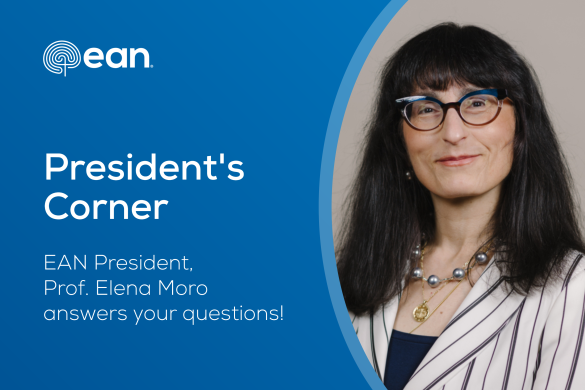by Peter Balicza
The European Academy of Neurology Regional Teaching Courses aim to bring neurological standards to Eastern countries, and to establish friendly relationships with colleagues from other countries. As a participant and EAYNT (European Association of Young Neurologist and Trainees) representative at the RTC I can say that this goal was more than fulfilled. The teaching course was organized with the National Society of Neurologists from Azerbaijan, with wonderful hospitality from Prof. Rena Shiraliyeva, Dr Rahim Aliyev and all of the Azerbaijani colleagues.
The participation was above expectations, 174 young physicists participated on the teaching course. Participants arrived from Azerbaijan, United States of America, Georgia, Netherlands, Iran, Uzbekistan, Kyrgyzstan, Belarus. This number of participants shows a high interest for being familiar with the up-to-date knowledge and guidelines in neurology, but also proved to be an ideal number for interaction between presenters and attendees. This is of great importance, since this was an opportunity for the young colleagues to ask from leading experts in the topics. All the presenters facilitated discussions, and questions during and after the lectures. Leading neurologist from Germany, Italy, Greece, Denmark, Hungary, Azerbaijan shared their knowledge to improve neurological care in the participants home countries. For this purpose practical points were emphasized by the presenters, and really important topics were covered from the large palette of neurology. The language of the workshop was in English, but simultaneous translation was also provided in Azerbaijani.
During the three days of the conference the morning lectures were more traditional presentations, but with discussions afterward, and during the afternoon interactive workshops were held. The first day was dedicated to headache. Prof. Jes Olesen talked about headache classification and diagnosis, emphasizing the importance of ICHD classification, and drew attention to other primary headache disorders beside migraine and tension-type headache and trigeminal autonomic cephalalgias. Prof. Jes Olesen as well as Prof. Messoud Ashina, who presented a useful approach to therapy, underlined the importance of medication-overuse headache. Prof. Dimos Mitsiakos from Greece helped the audience to be more effective when facing the complex situation of interconnected depression and headache. Prof. Rovshan Hasanov from Azerbaijan talked about the current status and future perspectives of headache clinics in Azerbaijan. During the afternoon, interactive workshops were organized involving patients, which was a great opportunity for the participants to apply their knowledge.
I also had the chance to talk to young colleagues about opportunities provided by the EAN to study abroad, attend to conferences and summer schools, and also EAYNT activities, which may be of interest of young neurologists, like informing through media, hospital visits during conferences, and other social events.
On the second day stroke was in the focuse. First, Prof. Laszlo Vecsei talked about the pathomechanism of stroke, and went beyond the basics by enlightening the connections with neurodegenerative disorders. The next two lecture on stroke treatment was really important for the Azerbaijani colleagues, since they face now the challenge to establish the ground for stroke thrombolytic therapy. Prof. Derk Wolfgang from Denmark talking about management of acute stroke, and Prof. Zaza Katsarava from Germany talking about organization of a stroke unit, held their lectures in this context. Prof. Sadaqat Huseynova from Baku presented a comprehensive lecture on the importance of rehabilitation after stroke. During the afternoon a gripping workshop was held with case presentations of stroke patients and a lot of interaction with the audience.
On the last day various themes were touched. Prof. Valeria Caso presented the complex issue of vascular dementia and difficulties, when trying to assess pre- and poststroke cognitive abilities. Prof. Fabio Blandini from Italy reviewed the pathophysiology of Parkinson’s disease. Prof. Detlef Kömpf, from Germany who held his lecture on eye movement disorders in clinical neurology helped the audience to connect neuroanatomy to clinical presentation and tests. Professor Fuad Ismaylov talked about how to treat depression in patients with neurodegenerative disorders.
It would be hard to list in a single report all the important issues covered during this three days, and a long book could be written about the hospitality of the hosting colleagues, and rich cultural and gastronomic experience we had in Azerbaijan. The faculty had the opportunity to get a feel for this beautiful city, with a long history and visited together the old town and within it the famous Maiden Tower and Shirvanshah’s palace with a guide. After the second day we had a wonderful gala dinner in a restaurant located in the courtyard of a XIV century khan, and tasted the best foods and wines of the Azerbaijani kitchen. The atmosphere of the whole teaching course was so friendly, that I am sure that not just me, but every participants enjoyed the interaction with each other, and appreciated learning more in neurology. I would like to thank all the people, organizers and participants who were involved in this regional teaching course.
Peter Balicza is neurologist working Budapest, Hungary. Her represented EAYNT at the Regional Teaching Course in Baku.


















